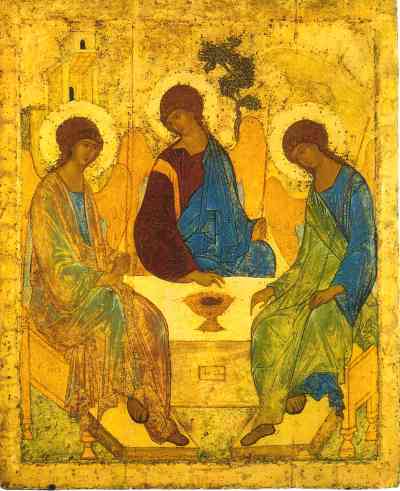
To answer the question briefly, icons can be defined as below: "an icon is a holy picture that is used at the Orthodox Church as medium for a prayer to God". We can easily get lost with the unfamiliar names and words, such medium for a prayer, a holy picture, and the Orthodox Church, but one should not spend too much time on trying to understand those terms. The best way to understand icons is to "look at" them.
Most of the people who see icons might have the impressions such as "mysterious", "scary" or even "grotesque". Before the "rediscovery of icons", between the end of the 19th century and the beginning of the 20th, even people in Europe had thought that icons were "grotesque". How come the icons became popular again in this modern age?
Can we regard icons as "art filled with exotic splendor"? That depends on the definition of "art", but one thing is clear: even though regarded as medium for a prayer to God throughout many centuries, to this day icons have kept their original style almost intact, and retained its supreme universality and completeness.
The golden age of Russian icons, between the 14th and 16th century, was blessed with the greatest masters such as Feofan Grek, Andrei Rublev, Master Dionisi.
The icon shown above, drawn by Andrei Rublev in the beginning of 15th century, is the treasured "The Holy Trinity", which is also known as "the icon of the icons". One can never fail to recognise the spirituality profound enough to oscillate one's soul with this highly sophisticated composition and through the three angels who came to Abraham.
Unfortunately, that supreme spirituality is rarely found in the Russian icons made after the golden period.
Various histories have been woven in icons. It is evident that icons are a kind of idols, which is strictly prohibited by the Old Testament. The reason that the Old Testament prohibited idols is that human beings are likely to fall into idolatry. Naturally, in the course of its long history, Orthodox icons fell victims twice to the extensive iconoclasm in the 8th and 9th century. But icons have survived. Why? There must be some reasons.
Let's take a moment and look
at many icons. You may find some icons that you can be fond of.
If you encountered the one, you would immediately find that icon talking
directly to you.
このページを見ている人ならば、「イコン」が英語でコンピュータの「アイコン」と同じ綴りであることをご存じでしょう。もちろんイコンの方がコンピュータよりも先にあったわけなので、GUIに「アイコン」という言葉が借用されたわけです。おかげで人々に単語は広く行き渡りました。でも、「イコン」がそもそも何であるかは残念ながらあまり正確には伝わっていないようです。
簡単に言ってしまえば、「イコンは東方正教会で神への祈りの媒体とされる聖画」です。東方正教会って?祈りの媒体って?聖画って?となじみのない言葉が続きますが、まずは何よりイコンを「見る」ことが、なによりの理解の早道です。そもそも、イコンとはそのような目的で作られたのですから。
イコンを見られた人の感想の多くは、「気持ち悪い」「おどろおどろしい」といったものかも知れません。それは、19世紀末から今世紀初頭の「イコンの再発見」以前のヨーロッパ人の感想でもありました。なぜ、近世になって再び脚光を浴びるようになったのでしょう? 一体どんな魅力があるのでしょう?
また、イコンは異国情緒にあふれた「芸術品」なのでしょうか? それは「芸術」の定義にもよりますが、言えることは「何世紀にもわたり神への祈りの媒体とされながらも、ほとんどその様式を変化させておらず、高度な普遍性と完成度を持っている」、ということです。
左上に示した15世紀初頭のイコンは、「イコンのなかのイコン」と呼ばれる人類の至宝、アンドレイ・ルブリョーフによる「三位一体」です。この極めて単純化された構図の中に、そしてアブラハムの前に現れた3人の天使を通じて、魂を揺さぶる深い精神性を感ぜずにはいられません。
しかし、フェオファーン・グレク、アンドレイ・ルブリョーフ、ディオニシが活躍した14−6世紀以降、イコンは急速にその高度な精神性を失ってしまいます。
イコンには様々な歴史が織り込まれています。明らかにイコンは、一種の「偶像」です。それは、旧約聖書で厳しく禁じられていることです。厳しく禁じられたのは、人間が偶像礼拝にきわめて陥りやすいからです。当然のようにイコンも、2回にわたる大規模な「イコノクラズム(聖画破壊運動)」にさらされました。では、なぜ今でもイコンは生き残っているのでしょう?なにか理由があるはずです。
多くのイコンを見て下さい。なにか好きなイコンが見つかるかも知れません。そうすれば、そのイコンは私などがクドクドと言うより遙かに雄弁にあなたの心に語りかけるはずです。